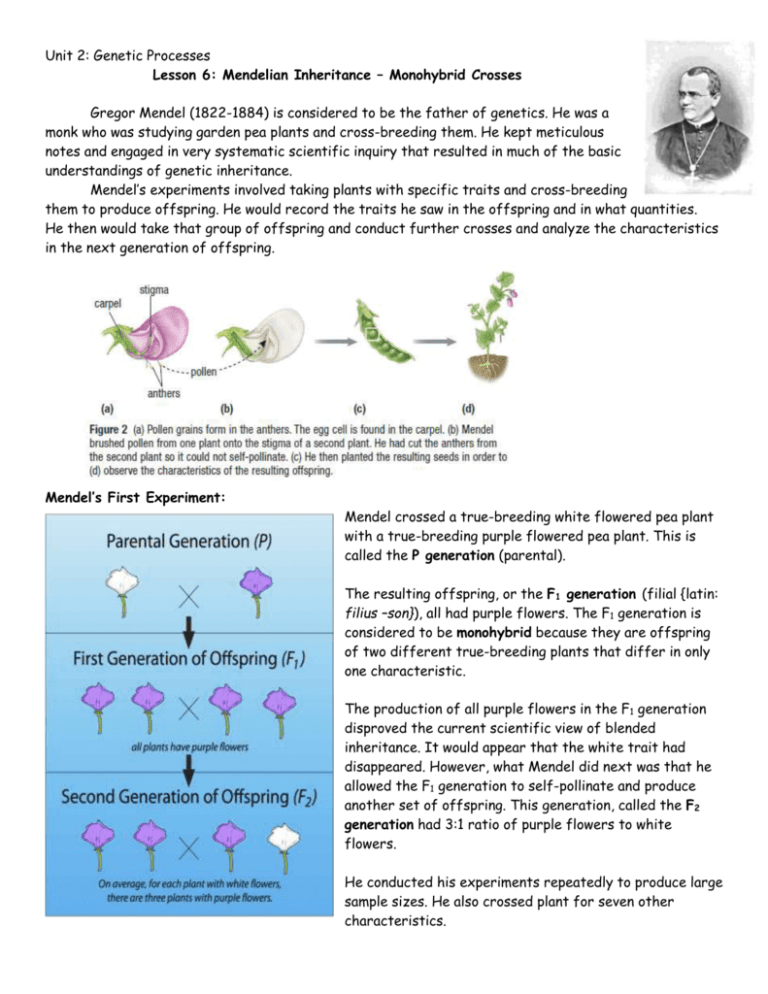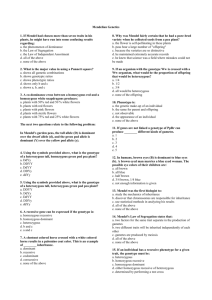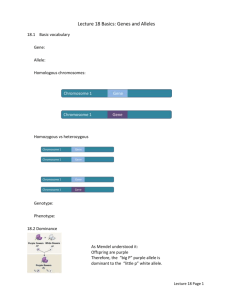Lesson 6 Mendelian genetics monohybrid crosses
advertisement

Unit 2: Genetic Processes
Lesson 6: Mendelian Inheritance – Monohybrid Crosses
Gregor Mendel (1822-1884) is considered to be the father of genetics. He was a
monk who was studying garden pea plants and cross-breeding them. He kept meticulous
notes and engaged in very systematic scientific inquiry that resulted in much of the basic
understandings of genetic inheritance.
Mendel’s experiments involved taking plants with specific traits and cross-breeding
them to produce offspring. He would record the traits he saw in the offspring and in what quantities.
He then would take that group of offspring and conduct further crosses and analyze the characteristics
in the next generation of offspring.
Mendel’s First Experiment:
Mendel crossed a true-breeding white flowered pea plant
with a true-breeding purple flowered pea plant. This is
called the P generation (parental).
The resulting offspring, or the F1 generation (filial {latin:
filius –son}), all had purple flowers. The F1 generation is
considered to be monohybrid because they are offspring
of two different true-breeding plants that differ in only
one characteristic.
The production of all purple flowers in the F1 generation
disproved the current scientific view of blended
inheritance. It would appear that the white trait had
disappeared. However, what Mendel did next was that he
allowed the F1 generation to self-pollinate and produce
another set of offspring. This generation, called the F2
generation had 3:1 ratio of purple flowers to white
flowers.
He conducted his experiments repeatedly to produce large
sample sizes. He also crossed plant for seven other
characteristics.
The results of Mendel’s careful analysis are summarized below:
Mendel’s Conclusions: The First Law of Mendelian Inheritance
Mendel analyzed his data and realized that in the F1 generation, the “dominant factor” was
expressed while the “recessive factor” remained hidden until it was expressed in the F2 generation.
What Mendel wondered was why would a trait present in the P generation not be expressed in the
offspring (F1) but then reappear in 25% of the second generation (F2). What he concluded from the
patterns he analyzed is now known as the law of segregation.
Law of Segregation:
1. Organisms inherit two copies of genes, one from each parent; for each characteristic, an
organism carries two genes – one from each parent
2. Organisms donate only one copy of each gene to their gametes because the genes separate
during gamete formation (during meiosis)
Alleles:
Each gene has a locus, or a position, on a chromosome. Most genes exist in at least two forms.
Each form of the gene is called an allele. Different allele combinations result in different traits for
that characteristic. If two alleles for a particular gene are the same, the individual is homozygous for
that allele. If an individual has two different alleles for a gene, the individual is heterozygous for that
gene. The set of alleles that an individual has is its genotype, where as the traits of an individual
comprises its phenotype. A dominant allele is an allele that expresses its phenotypic effect whenever it
is present in the individual. A recessive allele is expressed only when both alleles are of the recessive
form. Geneticists use letters to represent alleles. A capital letter represents the dominant allele and
the lower case letter represents the recessive allele.
In this diagram, we will use B to represent brown eyes
as it is the dominant allele, and b to represent blue
eyes as it is the recessive allele.
Individual A is heterozygous and has the genotype Bb.
Individual A’s phenotype is brown eyes.
Individual B is homozygous dominant and has the
genotype BB. Individual B’s phenotype is brown eyes.
Individual C is homozygous recessive and has the
genotype bb. Individual C’s phenotype is blue eyes.
Terminology:
Trait: a particular version of a characteristic that is inherited such as hair colour, or blood type. (note: do not
confuse characteristic for trait. Traits represent the variation within a characteristic. Ex: eye colour is a
characteristic whereas blue eyes or brown eyes are the trait.
True-breeding organism: an organism that produces offspring that are genetically identical for one or more traits
when self-pollinated or when crossed with another true-breeding organism for the same traits. Ex: if a truebreeding purple flowered pea plant is crossed with another true-breeding purple flowered pea plant, all offspring
plants will have purple flowers. The offspring of two different true-breeding plants are called hybrids.
Cross: the successful mating/breeding of two organisms from distinct genetic lines
P generation: the parent plants used in a cross
F1 generation: the offspring of a P-generation cross
F2 generation: the offspring of an F1 generation cross
Monohybrid: the offspring of two different true-breeding plants that differ in only one characteristic.
Monohybrid cross: a cross designed to study the inheritance of only one trait
Allele: a specific form of a gene
Heterozygous: describes an individual that carries two different alleles for a given characteristic
Homozygous: describes an individual that carries two of the same alleles for a given characteristic
Genotype: the genetic makeup of an individual
Phenotype: an individual’s outward appearance with respect to a specific characteristic
Dominant Allele: the allele that, if present, is always expressed. This is due to the fact that the dominant allele
usually codes for a working protein whereas the recessive allele does not.
Recessive Allele: the allele that is expressed only if it is not in the presence of the dominant allele, that is, if the
individual is homozygous for the recessive allele
Genetic Problems – Monohybrid Crosses
Punnett Squares: a diagram that summarizes every possible combination of each allele from each
parent; a tool for determining the probability of a single offspring having a particular genotype.
Ex 1: In pea plants, the allele for yellow seed colour, Y, is dominant over that for green seed colour, y. A
pea plant that is homozygous for yellow seeds is crossed with a plant that is homozygous recessive.
Determine the possible genotypes and phenotypes of the F1 generation.
Ex 2: Two heterozygous yellow seed pea plants are crossed. Determine the genotypic and phenotypic
ratios of the offspring generation.
Ex 3: In one cross of tomato plants, 1821 red tomato plants and 615 yellow tomato plants were
produced. Determine the probable genotype of the parents. Which allele is dominant? Assume that the
trait is influenced by only two alleles and follows the laws of Mendelian inheritance. Use R and r to
represent that alleles.
The Test Cross:
When an organism has a dominant phenotype, it could have either the homozygous dominant genotype or
the heterozygous dominant genotype. Since genotypes are not visible unless you conduct extensive DNA
gene sequencing, how can you tell if an organism is a carrier for the recessive allele or not? The answer
lies in doing a test cross. A test cross is a cross used to determine the genotype of an individual
expressing a dominant trait.
Ex 4: A breed of roosters has a dominant trait (S) for a comb that resembles 5-fingers and a recessive
trait (s) for a flat comb. A breeder would like to
use a true-breeding, homozygous, five-fingered
comb rooster as a stud in her breeding program.
She has many roosters to choose from, but she
does not know if they are heterozygous or
homozygous.
a) What type of hen should she cross with
the roosters? Explain why?
b) What are the expected results?
Homework:
1. A researcher crossed a homozygous yellow seed plant (YY) and a heterozygous yellow seed plant
(Yy). Determine the genotype and phenotype ratios of the offspring.
2. A researcher crossed a heterozygous yellow seed plant (Yy) and a recessive green seed plant (yy).
Determine the genotype and phenotype ratio of the offspring.
3. The gene for whisker length in seals occurs in two different alleles. The dominant allele (W)
codes for long whiskers, and the recessive allele (w) codes for short whiskers.
a) If one parent is heterozygous long-whiskered and the other parent is short-whiskered, what
percentage of offspring would you expect to have short whiskers?
b) A male long-whiskered seal is mated in captivity with a number of different females. With
some females all their offspring are long-whiskered, and with some females there are both
long- and short-whiskered offspring.
i) What is the genotype of the male? How can you be sure?
ii) Would it be possible to find a female mate that would produce only short-whiskered
offspring? Explain.
4. Mendel found that crossing wrinkle-seeded (rr) plants with homozygous round-seeded (RR) plants
produced only round-seeded plants. What genotype ratio and phenotype ratio can be expected
from a cross between a wrinkle-seeded plant and a heterozygous plant for this characteristic?
5. The round pea seed allele (R) is dominant, while the wrinkled pea seed allele (r) is recessive. A
heterozygous, round-seeded pea plant is crossed with a wrinkle-seeded pea plant. Use a Punnet
square to solve the following:
a) Determine the predicted genotype ratio of the offspring.
b) Determine the predicted phenotype ratio of the offspring.
c) If this cross produced 50 plants, how many plants would you predict would be wrinkleseeded pea plants?
6. Humans who have an abnormally high level of cholesterol are said to suffer hypercholesterolemia.
The gene for this disorder is dominant (C). A man who is heterozygous for familial
hypercholesterolemia marries a woman who is homozygous for the recessive allele. What is the
probability that they will have children that suffer from this disorder?
7. Holstein dairy cattle normally have black and white spotted coats. On occasion calves with
recessive red and white spotted coats are born. A dairy farmer purchases a prized black and
white spotted bull. To the farmer’s dismay the bull produces a red and white spotted calf when
mated to one of his cows.
a) What is the genotype of the bull?
b) What phenotype ratio is expected in the offspring if the bull is mated to a red and white
spotted cow?
Full Solutions:
1.
2.
3.
4.
5.
6.
7.









